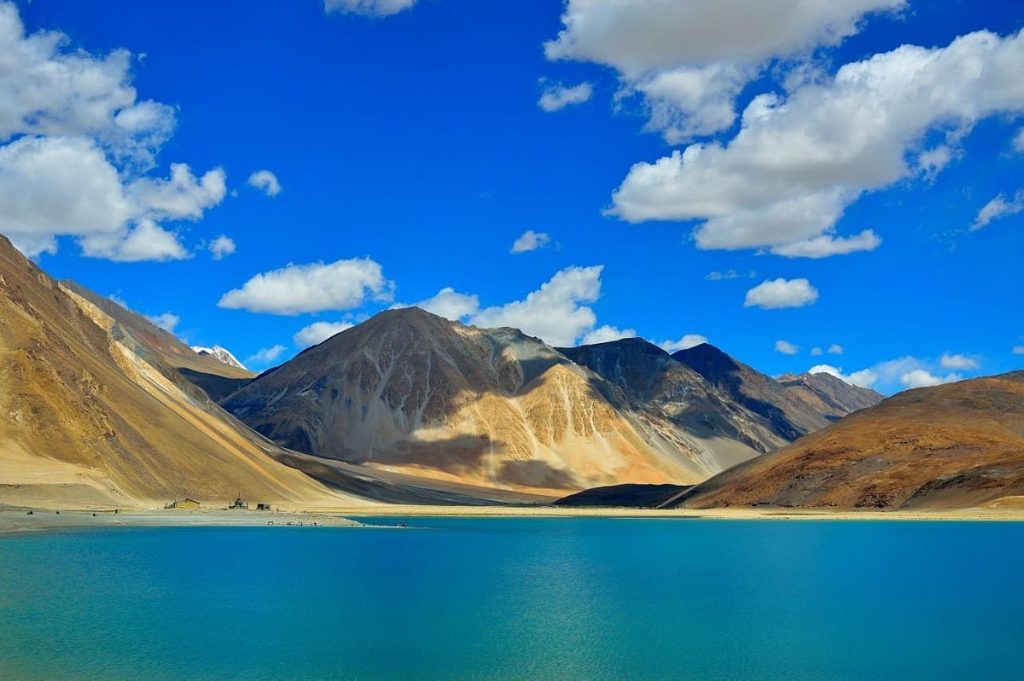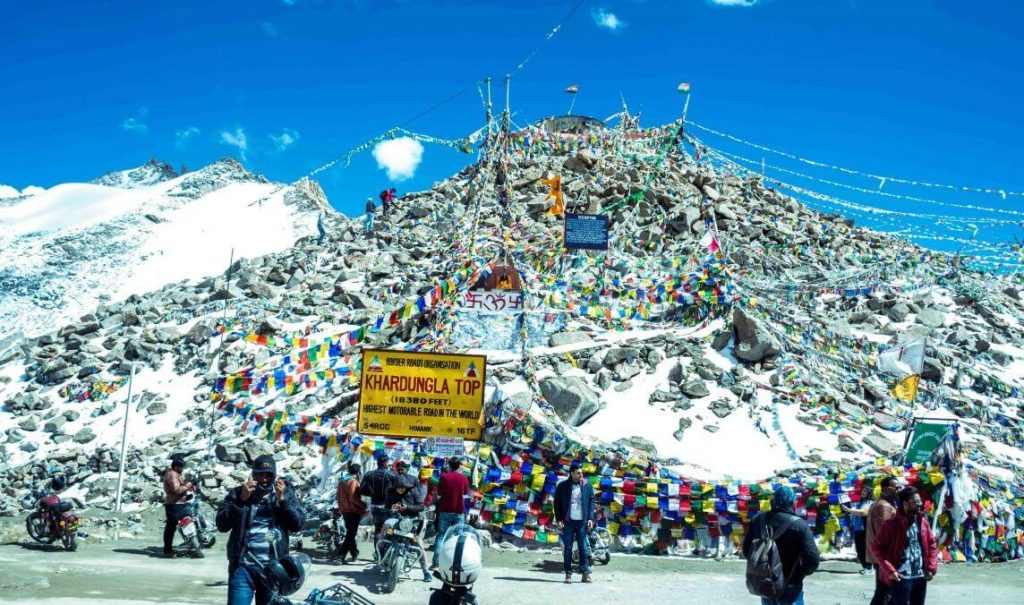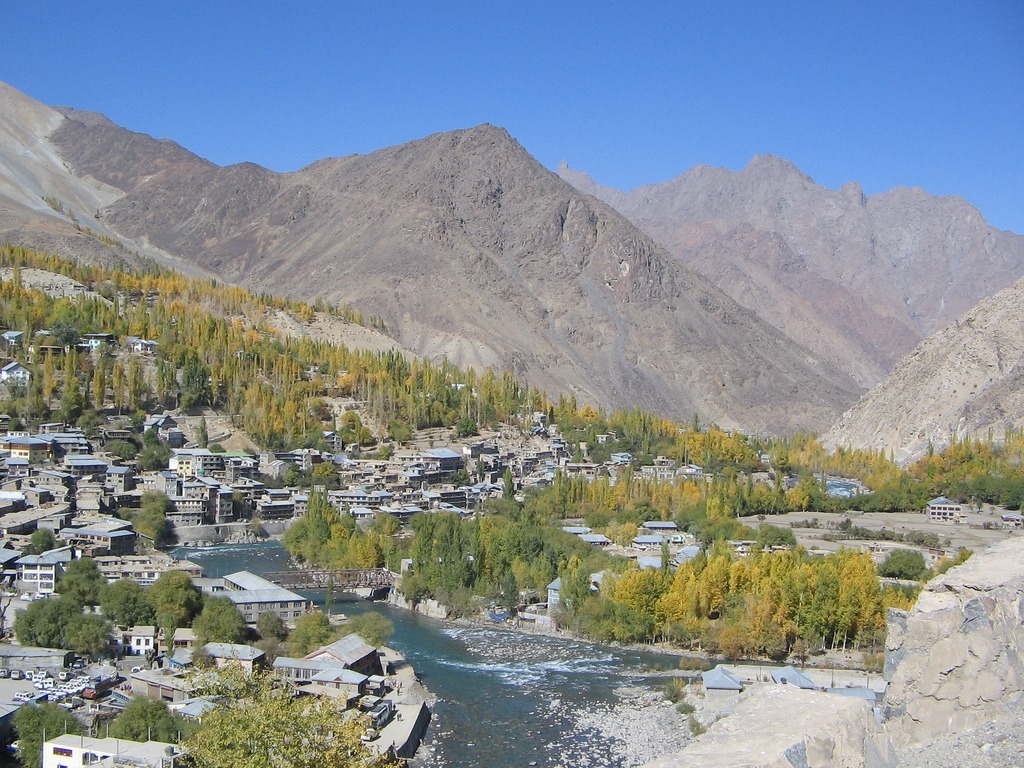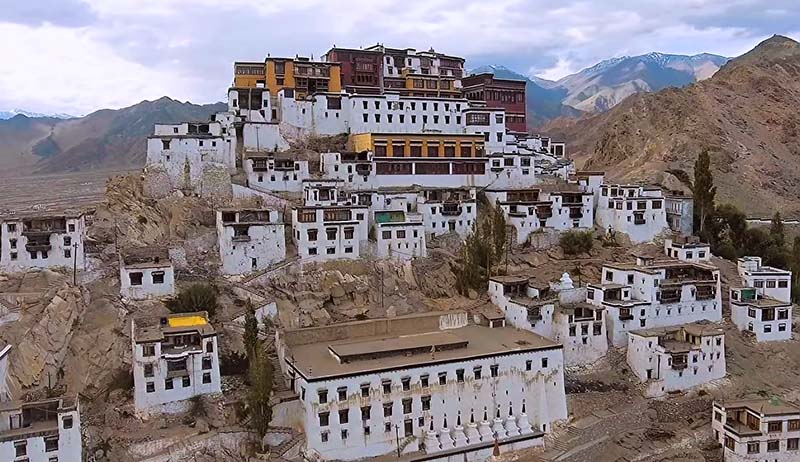Redefining what breathtaking beauty truly means, Ladakh offers the most stunning views of the Himalayan wilderness, stretching from Siachen Glacier to the Great Himalayas. Previously a part of Jammu and Kashmir, it was declared as a union territory in 2019 and has always been a treasured tourist destination. It is known as the world’s coldest desert with terrain unlike any other part of the country. ‘La’ meaning a pass and ‘Dakh’ meaning the land, defining how the region is the land of passes.Ladakh is divided into two major districts- Leh and Kargil. Leh is a popular destination for its attractions like historic monasteries, Shanti Stupa, cafes, and Leh Bazaar, while Kargil is majorly under the Indian army and has some monuments dedicated to the Kargil warriors.
Redefining what breathtaking beauty truly means, Ladakh offers the most stunning views of the Himalayan wilderness, stretching from Siachen Glacier to the Great Himalayas. Previously a part of Jammu and Kashmir, it was declared as a union territory in 2019 and has always been a treasured tourist destination. It is known as the world’s coldest desert with terrain unlike any other part of the country. ‘La’ meaning a pass and ‘Dakh’ meaning the land, defining how the region is the land of passes. Ladakh is divided into two major districts- Leh and Kargil. Leh is a popular destination for its attractions like historic monasteries, Shanti Stupa, cafes, and Leh Bazaar, while Kargil is majorly under the Indian army and has some monuments dedicated to the Kargil warriors. With some unmatched views, exploring the mountains in this region is truly a surreal experience. Every valley unearths a new terrain that is bound to take your breath away. Ladakh, a former Buddhist Kingdom, is a quaint town with glimpses of Tibetan culture at every corner. Also home to some mesmerizing Buddhist monasteries, as you explore this small town the freshness in the air and sound of prayer flags in the rushing wind simply transports you to a fairyland. The local community has ensured to keep the local culture alive keeping the sensitive environment in mind. The region is also popular for some of the thrilling treks and rafting experiences on the Zanskar River. A place blessed both naturally and culturally, Ladakh will unlock a new Incredible India for you. Here is a look at some of the major attractions in the union territory that you should not miss out on.
Eye-Catching Places to Visit in Ladakh

Pangong Lake
The Pangong Lake, one of the most prominent tourist attractions, stretches about 12 kms from India to Tibet. This remarkable lake does not remain blue throughout the year or sometimes even a day shifting from azure to light blue to green and grey. The Pangong Lake's temperature swings from -5°C to 10°C due to its height, and as a result, it freezes entirely in the winter despite its
The Pangong Lake, one of the most prominent tourist attractions, stretches about 12 kms from India to Tibet. This remarkable lake does not remain blue throughout the year or sometimes even a day shifting from azure to light blue to green and grey. The Pangong Lake's temperature swings from -5°C to 10°C due to its height, and as a result, it freezes entirely in the winter despite its salinity. The shiny blue waters with the backdrop of the mighty Himalayan mountains makes an interesting backdrop for pictures. Many Bollywood movies have been shot here and you’ll find some local props set up making perfect selfie points for your Ladakh picture gallery. Located on the Sino-Indian Actual Line of Control, it requires an inner line permit to visit this enchanting lake. Individual permits are easy to obtain for Indian nationals, while foreign nationals must obtain a group permission. During the winter season, the lake becomes home to thousands of migratory birds making a halt in their journey. It is ideal for bird watchers and nature lovers to explore the region during that time as it adds a unique charm to the natural setting.
Khardung La
Situated at 5602 metres above the sea level, Khardung La is the highest motorable road in the country. Serving as the entry point to Shyok and Nubra Valley, it is ideal for mountain biking enthusiasts and bike riders who want to ride on the highest motorable road in the country. The pass was constructed in 1976 and only later in 1988 opened to the public. The pass plays a crucial role
Situated at 5602 metres above the sea level, Khardung La is the highest motorable road in the country. Serving as the entry point to Shyok and Nubra Valley, it is ideal for mountain biking enthusiasts and bike riders who want to ride on the highest motorable road in the country. The pass was constructed in 1976 and only later in 1988 opened to the public. The pass plays a crucial role in transportation of supplies to the Siachen Glacier. Revealing some majestic views of the Karakoram range, this pass has now become a major tourist attraction for people visiting Ladakh. Historical notes show that the pass was also the quickest route to get to China during World War II. Tourists must get an Inner Line Permit in order to enter and travel through the pass. From October to May, the Khardung La pass is closed due to severe rains and snowfall


Nubra Valley
Beautiful images of camels across the mountain desert pop up when you google Nubra Valley but the actual scenery however reveals beauty beyond one’s imagination. Located about 140 kms from Leh, the region includes majestic views of the Shyok and Nubra rivers, picturesque monasteries and some adventure-filled activities. Part of the ancient Silk Route, the valley is known for its
Beautiful images of camels across the mountain desert pop up when you google Nubra Valley but the actual scenery however reveals beauty beyond one’s imagination. Located about 140 kms from Leh, the region includes majestic views of the Shyok and Nubra rivers, picturesque monasteries and some adventure-filled activities. Part of the ancient Silk Route, the valley is known for its Bactrian camel rides against the backdrop of the mountains. The rarest of all camels only found in these regions, they have two humps and were used as the main modes of transportation for the Silk Route. Now it is a fun activity and photo opportunity as you explore the region through a camel ride. The 32-meter Maitreya Buddha statue located near Diskit Monastery in Nubra Valley is also well-known. The area is currently under military control because the route connects to the Siachen base camp, which is also the world's highest battleground. The most popular route to Nubra Valley from Leh is via Khardung La so you can plan your trip accordingly.
Shanti Stupa
Another postcard worthy destination of Ladakh, the Shanti Stupa shines brightly perched at a rocky hilltop due to its white domed construction. A Japanese Buddhist Bhikshu Gyomyo Nakamura built the monument in 1991 to commemorate the 2500th anniversary of Buddhism and promote world peace. A sacred site for the Buddhist community, it also houses Buddha’s remains sanctified
Another postcard worthy destination of Ladakh, the Shanti Stupa shines brightly perched at a rocky hilltop due to its white domed construction. A Japanese Buddhist Bhikshu Gyomyo Nakamura built the monument in 1991 to commemorate the 2500th anniversary of Buddhism and promote world peace. A sacred site for the Buddhist community, it also houses Buddha’s remains sanctified by the 14th Dalai Lama. It is also part of the peace pagoda mission, which seeks to foster peace via Buddha's teachings. Offering a panoramic view of Leh and nearby town Chanspa, it is a mesmerizing sight best for capturing breathtaking moments in your camera. Many specially capture it in full moon light when the stupa shines naturally under the bright moonlight. While the ride towards the monument is a thrilling adventure, the sight in itself is so peaceful that it instantly calms the mind.


Kargil
Situated along the banks of river Indus, 2676 meters above the sea level, Kargil has been known for its cultural and political significance. Playing an important role in the Indo Pak war of 1999, the second largest city of Ladakh is now home to various memorial and historical monuments. Many documentaries and movies have been made on the area due to the same reason gaining
Situated along the banks of river Indus, 2676 meters above the sea level, Kargil has been known for its cultural and political significance. Playing an important role in the Indo Pak war of 1999, the second largest city of Ladakh is now home to various memorial and historical monuments. Many documentaries and movies have been made on the area due to the same reason gaining attention of more tourists across the country. It is best explored via a day trip from Ladakh with the striking backdrop of the Himalayan mountain range and Indus river running alongside.
Thiksey Monastery
Perched on top of a mountain offering a mind blowing view of the valley, the Thiksey monastery offers a unique glimpse into Buddhist culture and teachings. With numerous stupas, artworks and Buddhist artifacts spread across the place, it is best explored on foot with the help of a local. The Tibetan styled monastery is about 19 kms from Leh and houses a temple built to honor the Dalai
Perched on top of a mountain offering a mind blowing view of the valley, the Thiksey monastery offers a unique glimpse into Buddhist culture and teachings. With numerous stupas, artworks and Buddhist artifacts spread across the place, it is best explored on foot with the help of a local. The Tibetan styled monastery is about 19 kms from Leh and houses a temple built to honor the Dalai Lama. Many come here to simply witness this architectural marvel with their own eyes and take some memorable shots of the place.

Activities Not to Be Missed in Ladakh
Festivals of Leh Ladakh
Mouthwatering Meals of Ladakh
Situated at such height and its extreme weather conditions have led the local people to create their own nourishing cuisine with foreign influences. The local restaurants serve everything from India, Tibetan, Chinese and even Korean. Some of the most popular dishes to try here are Thukpa (noodle soup) Tsampa, known in Ladakhi as Ngamphe (roasted barley flour), and Skyu which is a heavy pasta dish with plenty of veggies as well as the very popular and delicious Momos which are
Situated at such height and its extreme weather conditions have led the local people to create their own nourishing cuisine with foreign influences. The local restaurants serve everything from India, Tibetan, Chinese and even Korean. Some of the most popular dishes to try here are Thukpa (noodle soup) Tsampa, known in Ladakhi as Ngamphe (roasted barley flour), and Skyu which is a heavy pasta dish with plenty of veggies as well as the very popular and delicious Momos which are steamed dumplings stuffed with vegetables or meat. The local kahwa made of water, tea and Indian spices is the best way to break the cold of the region. Some other drink offerings include tea, coffee, beer and Chang which is an alcoholic beverage drunk specially on festive occasions.
Shopping at Ladakh
When to visit Ladakh
The best time to visit Rishikesh for white water rafting is September-June and November. Another good time to visit Rishikesh is from February to early May. The International Yoga Festival is organised in Rishikesh in the first week of March. It is not favourable to visit Rishikesh in summer (May-June) as the temperature during these months gets extremely high, making it unbearable for sightseeing.Ladakh
How to reach Ladakh
Want To find out more about Our Popular Tours ?
Get in touch one of our destination specialists.
Other Popular Tourist Places
Punjab
Beautifully representing India’s partition history, northern cultural traditions and delectable cuisines, one should explore Amritsar
Andhra Pradesh
Overlooked by many, Andhra Pradesh is one of India’s most diverse states, home to some underappreciated treasures that can add
Himachal Pradesh
India’s northern region is blessed with the mighty Himalayan range, but only as you explore the states you realize that even the
Telangana
Telangana is a state in southern India. In the capital of Hyderabad, the Charminar is a 16th-century mosque with 4 arches supporting 4 towering minarets
Karnataka
No better title than ‘One State Many Worlds’ to describe the plethora of experiences that this state has to offer. This ancient yet
Jammu and Kashmir
Titled as ‘Paradise on Earth’, Kashmir offers magnificent beauty that not only leaves one speechless but turns every soul into a
Kerala
God’s own country, Kerala, is such an enticing destination in terms of an experience that one wonders what to add and what to skip
Leh Ladakh
Redefining what breathtaking beauty truly means, Ladakh offers the most stunning views of the Himalayan wilderness, stretching
Lakshadweep
A beautiful set of islands set on the eastern coast of Arabian Sea come together to form India’s smallest union territory, Lakshadweep
Madhya Pradesh
Known to be the heart of India, Madhya Pradesh offers a bouquet of cultural experiences topped with the sparkle of unique landscapes
Delhi
Delhi, the city of garden and park, is the capital and union territory of India. It constitutes two quite distinctive worlds, New Delhi and
Pondicherry
A reminiscent of French culture and architecture, this small town near Chennai is one of Tamil Nadu’s top destinations among travellers.
Rajasthan
This incredible state of India, said to be the Land of Kings offers great history, vibrant culture, prolific wildlife and amazing hospitality.
Tamil Nadu
India, known for its cultural beauty, surprises you through every state, city, district, corner. One such gem showcasing the diversity of South India
Uttar Pradesh
Situated right in the centre of India, Uttar Pradesh is home to some of the most ancient cities that have shaped a distinctive culture
Uttarakhand
opularly known as the ‘Devbhumi’ or ‘Land of the Gods’, Uttarakhand is a prominent pilgrimage destination with abundant natural beauty. Home to the two sacred
Maharashtra
Arising from a vibrant history, the naturally blessed state of Maharashtra is home to a broad range of historic sites, national parks and cultural legacy.
Gujarat
The westernmost state of the country, bordering Pakistan has a varied landscape ranging from the forests of Gir to the hills of Diu and the white sand
Goa
Topped as one of the country’s favourite holiday destinations, everyone travelling to India is either planning a trip to Goa or has already added a thoroughly
Bihar
This east Indian state bordered by Uttar Pradesh, West Bengal, Jharkhand and Nepal is said to be the birthplace of Buddha. Situated on the Gangetic plains
Odisha
Odisha is known to be the land of myriad marvels as the state boasts of more than 20,000 temples with historic culture. While the state has previously
West Bengal
Titled the, ‘Sweetest part of India,’ West Bengal comprises stunning landscapes, majestic forests, coastal beauty, rich history and the unspoiled Sunderbans.
The Seven Sister States Of India
India is such a vast and beautiful country with so many options for travelling that one might feel confused as to what to see and what to miss. No matter
Andaman And Nicobar
Andaman and Nicobar Islands in the Bay of Bengal on the eastern side is another lesser explored destination of the country. The 572-island archipelago is a

























